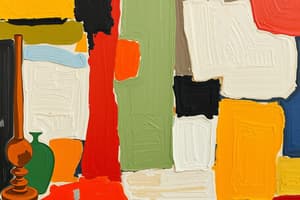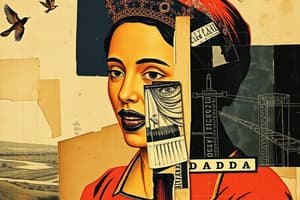Podcast
Questions and Answers
What is the significance of linear perspective in Renaissance art?
What is the significance of linear perspective in Renaissance art?
- It removes depth from the painting.
- It allows artists to depict a flat surface convincingly. (correct)
- It emphasizes the emotional aspect of the artwork.
- It focuses on the use of color exclusively.
Which author wrote a book criticizing the government and outlining his political beliefs in the Renaissance?
Which author wrote a book criticizing the government and outlining his political beliefs in the Renaissance?
- Thomas More
- Niccolò Machiavelli (correct)
- Michelangelo
- Leonardo da Vinci
What concept did the term 'humanism' primarily emphasize during the Renaissance?
What concept did the term 'humanism' primarily emphasize during the Renaissance?
- The importance of nature in religious practices.
- An adherence to strict social hierarchies.
- A focus on the divine and religious doctrines.
- An interest in the humanities and individual achievement. (correct)
Which of the following does NOT represent a characteristic of Renaissance art?
Which of the following does NOT represent a characteristic of Renaissance art?
What is a vanishing point in art?
What is a vanishing point in art?
Who is considered a well-rounded individual in the context of the Renaissance?
Who is considered a well-rounded individual in the context of the Renaissance?
What was a primary focus of secular works during the Renaissance?
What was a primary focus of secular works during the Renaissance?
What does 'chiaroscuro' refer to in the context of Renaissance art?
What does 'chiaroscuro' refer to in the context of Renaissance art?
What is considered Francesco Petrarch's main contribution to literature?
What is considered Francesco Petrarch's main contribution to literature?
Which of the following artworks is NOT attributed to Leonardo da Vinci?
Which of the following artworks is NOT attributed to Leonardo da Vinci?
What innovation is Johann Gutenberg credited with developing?
What innovation is Johann Gutenberg credited with developing?
Which statement best describes the work of Donatello?
Which statement best describes the work of Donatello?
Erasmus's 'In Praise of Folly' primarily critiques what aspect of the church?
Erasmus's 'In Praise of Folly' primarily critiques what aspect of the church?
Raphael's 'The School of Athens' features which prominent theme?
Raphael's 'The School of Athens' features which prominent theme?
What significant change did the Medici family bring to Florence?
What significant change did the Medici family bring to Florence?
Hans Holbein the Younger's portraits typically aimed to convey what about his subjects?
Hans Holbein the Younger's portraits typically aimed to convey what about his subjects?
Flashcards are hidden until you start studying
Study Notes
Key Terms
- Perspective: Technique to create a 3D image on a flat surface; illustrates multiple sides of objects.
- Depth: Concept that objects farther away appear smaller.
- Linear Perspective: Mathematical approach to creating realistic depth in art.
- Realism: Renaissance art characterized by accurate anatomy, muscle tone, and proportion.
- Humanism: Study of humanities (rhetoric, poetry, science, literature, art) emphasizing individual achievement rather than religious themes.
- Secular: Non-religious works; increased prominence during the Renaissance.
- Renaissance: European period (1400-1800) marked by a revival of classical Greek and Roman ideas.
- Utopia: Thomas More's book depicting an ideal society focused on unity and criticism of societal pride.
- Patron: Wealthy sponsor of the arts, often monarchs or influential figures.
- Clergy: Members of religious institutions.
- Well-rounded: Describes individuals like Leonardo da Vinci, who excelled in diverse fields (science, art, etc.).
- Pagan: Religious systems centered around nature and multiple gods; do not follow a singular religious text.
- Vanishing Point: Point in an image where parallel lines converge, directing focus.
- Humanization of the Divine: Depicting biblical figures with human characteristics, emphasizing human achievement.
- Horizon Line: Meeting point of sky and ground; absent in medieval art.
- Background: Renaissance art included detailed backgrounds, unlike the flat colors of medieval styles.
- Chiaroscuro: Technique of using light and shadow in art, first prominent in the Renaissance.
Key People
- Niccolò Machiavelli: Author of The Prince, advocating for realistic governance over ethical considerations; believed in the necessity of fear in leadership.
- Francesco Petrarch: Wrote love poems to Laura; stressed classical education and ethical living influenced by Roman examples.
- Leonardo da Vinci: Renowned artist of Mona Lisa and The Last Supper; combined scientific methods with art to achieve realism.
- Michelangelo: Creator of the Sistine Chapel and St. Peter's Basilica, merging new ideas of beauty with religious themes.
- Johann Gutenberg: Invented the printing press with movable type; democratized access to books, including the Bible, enhancing education.
- Erasmus: Writer of In Praise of Folly, critiquing the church for its rituals and advocating for church reform; viewed as a Christian Humanist.
- Donatello: Sculptor of David and Mary Magdalene; first nude brass statue since classical era, known for emotional realism and versatility.
- Raphael: Created The School of Athens, showcasing prominent Greek philosophers and their ideas.
- Botticelli: Noted for his distinct artistic style during the Renaissance.
- Medici Family: Influential ruling family of Florence; significant patrons of the arts, notably supporting Donatello.
- Christian Humanists: Advocated for societal and church reform; exemplified by Erasmus, who sought to improve the church by addressing its flaws.
- Hans Holbein the Younger: Renowned for portraits of powerful figures like King Henry VIII and Thomas More, capturing their likeness and authority.
Studying That Suits You
Use AI to generate personalized quizzes and flashcards to suit your learning preferences.




